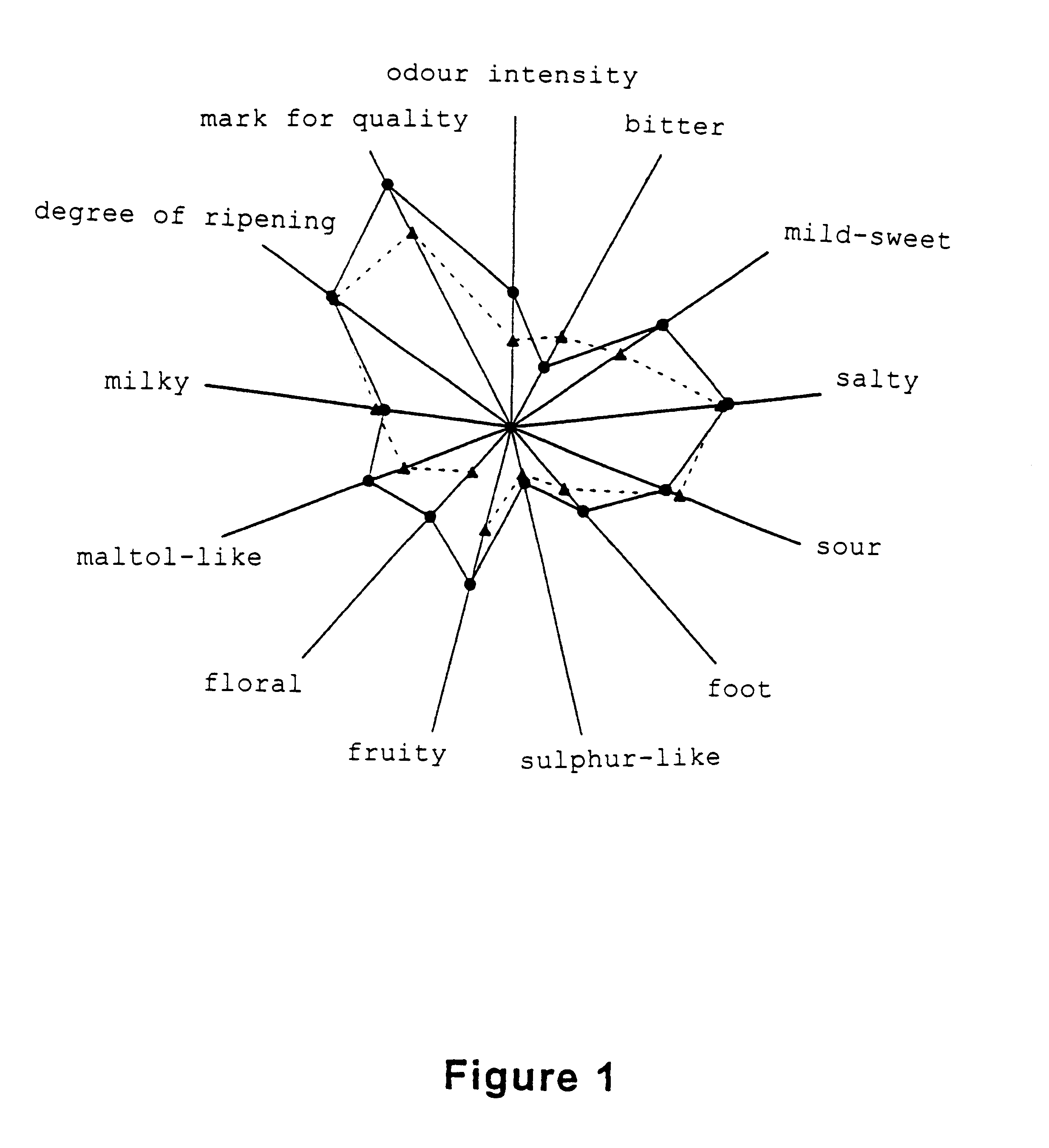Use of keto acids to enhance the flavor of cheese products
- Summary
- Abstract
- Description
- Claims
- Application Information
AI Technical Summary
Problems solved by technology
Method used
Image
Examples
example 2
Effect of the Addition of .alpha.-Ketoglutarate to Cheeses on the Degradation of Phenylalanine
Manufacture of Uncooked Pressed Cheese with Artificial Rind
Five small cheeses of the Saint-Paulin type (250 g) were manufactured from 10 liters of partially skimmed milk (32 g of fat per liter) and pasteurized for 1 min at 750.degree. C. The milk is inoculated at the rate of 2% with an overnight culture of Lactococcus lactis (strain NCDO763 of Lactococcus lactis ssp cremoris) in skimmed milk. The renneting is carried out immediately at 33.degree. C. using 0.03% of rennet (520 mg / l of chymosin, SBI, France). During the stirring, lactose is partially removed from the curd by replacing 30% of the whey with water at 32.degree. C. The curd is then moulded in KADOVA-type moulds and pressed.
Salting and Ripening of the Cheeses
After pressing, one of the cheeses is cut into small cylinders of about 3 g (mini cheeses) for the analysis of the degradation of phenylalanine.
Two brines were used for the mi...
example 3
Effect of the Addition of .alpha.-Ketoglutarate to Cheeses on their Organoleptic Quality
250 g cheeses of the Saint-Paulin type are manufactured as described in Example 2 above.
Two of these cheeses are immersed for 3 hours in 2 liters of brine containing 250 g of NaCl per liter and 2 others in 2 liters of brine containing 250 g of NaCl and 50 g of .alpha.-ketoglutarate per liter.
Moreover, two other cheeses are each cut into 10 pieces of 25 g. Ten of these pieces are immersed for 2 h 30 min in 0.75 liter of brine containing 100 g of NaCl and the other ten in 0.75 liter of a brine containing 100 g of NaCl and 30 g of .alpha.-ketoglutarate per liter.
The pH of all the brines is previously adjusted to 5.7 with lactic acid.
After salting, the cheeses are stored in a refrigerator overnight; the next day, they are coated with edible wax and placed in a cellar at 13.degree. C.
Organoleptic Analyses
These analyses were carried out on 250 g cheeses.
The cheese with .alpha.-ketoglutarate and the con...
example 4
Effect of the Addition of .alpha.-Ketoglutarate to Cheeses on the Degradation of Amino Acids
The free amino acids present in the cheeses used in Example 3 were assayed after 14 days of ripening.
Extraction and Analysis of Free Amino Acids
The free amino acids are extracted from the cheeses according to the protocol described for the extraction of the products of degradation of phenylalanine in Example 1. They are then analysed with the aid of an LC3000 automated amino acid analyser (BIOTRONIK) under the conditions recommended by the manufacturer of the apparatus.
Results
Table III below indicates the quantities of each amino acid (in nmol / g of cheese) in the control cheese and in the cheese with ketoglutarate. It also indicates the difference between these quantities, expressed, on the one hand, in nmol / g of cheese, and, on the other hand, in % of the quantity in the control cheese.
These results show that the quantities of methionine, isoleucine, leucine and phenylalanine in the cheese r...
PUM
 Login to View More
Login to View More Abstract
Description
Claims
Application Information
 Login to View More
Login to View More - R&D
- Intellectual Property
- Life Sciences
- Materials
- Tech Scout
- Unparalleled Data Quality
- Higher Quality Content
- 60% Fewer Hallucinations
Browse by: Latest US Patents, China's latest patents, Technical Efficacy Thesaurus, Application Domain, Technology Topic, Popular Technical Reports.
© 2025 PatSnap. All rights reserved.Legal|Privacy policy|Modern Slavery Act Transparency Statement|Sitemap|About US| Contact US: help@patsnap.com



